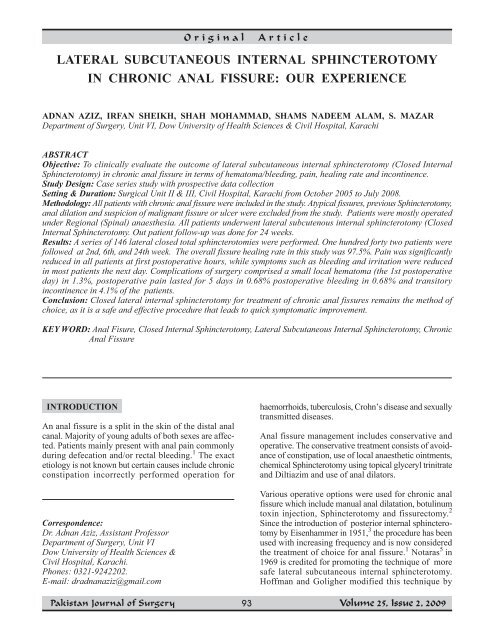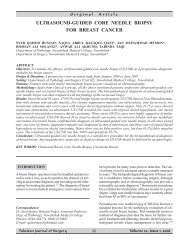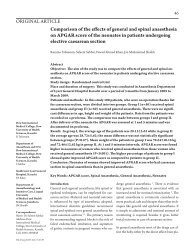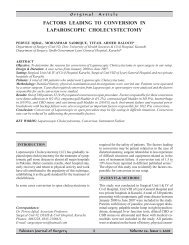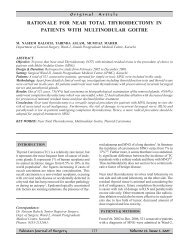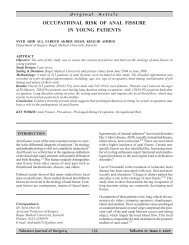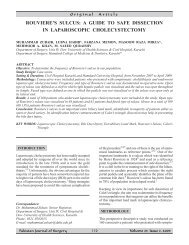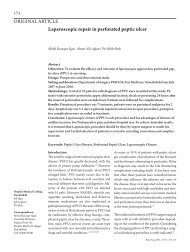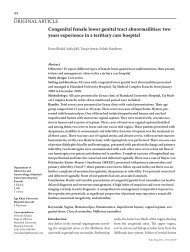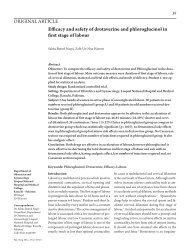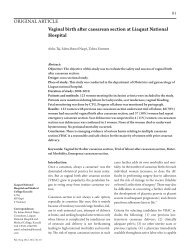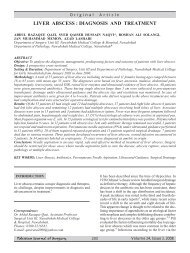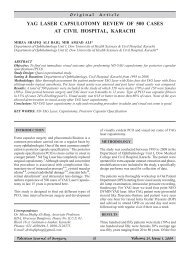Lateral subcutaneous internal sphincterotomy in Chronic Anal Fissure
Lateral subcutaneous internal sphincterotomy in Chronic Anal Fissure
Lateral subcutaneous internal sphincterotomy in Chronic Anal Fissure
Create successful ePaper yourself
Turn your PDF publications into a flip-book with our unique Google optimized e-Paper software.
Orig<strong>in</strong>al<br />
Article<br />
LATERAL SUBCUTANEOUS INTERNAL SPHINCTEROTOMY<br />
IN CHRONIC ANAL FISSURE: OUR EXPERIENCE<br />
ADNAN AZIZ, IRFAN SHEIKH, SHAH MOHAMMAD, SHAMS NADEEM ALAM, S. MAZAR<br />
Department of Surgery, Unit VI, Dow University of Health Sciences & Civil Hospital, Karachi<br />
ABSTRACT<br />
Objective: To cl<strong>in</strong>ically evaluate the outcome of lateral <strong>subcutaneous</strong> <strong><strong>in</strong>ternal</strong> <strong>sph<strong>in</strong>cterotomy</strong> (Closed Internal<br />
Sph<strong>in</strong>cterotomy) <strong>in</strong> chronic anal fissure <strong>in</strong> terms of hematoma/bleed<strong>in</strong>g, pa<strong>in</strong>, heal<strong>in</strong>g rate and <strong>in</strong>cont<strong>in</strong>ence.<br />
Study Design: Case series study with prospective data collection<br />
Sett<strong>in</strong>g & Duration: Surgical Unit II & III, Civil Hospital, Karachi from October 2005 to July 2008.<br />
Methodology: All patients with chronic anal fissure were <strong>in</strong>cluded <strong>in</strong> the study. Atypical fissures, previous Sph<strong>in</strong>cterotomy,<br />
anal dilation and suspicion of malignant fissure or ulcer were excluded from the study. Patients were mostly operated<br />
under Regional (Sp<strong>in</strong>al) anaesthesia. All patients underwent lateral subcutenous <strong><strong>in</strong>ternal</strong> <strong>sph<strong>in</strong>cterotomy</strong> (Closed<br />
Internal Sph<strong>in</strong>cterotomy. Out patient follow-up was done for 24 weeks.<br />
Results: A series of 146 lateral closed total sph<strong>in</strong>cterotomies were performed. One hundred forty two patients were<br />
followed at 2nd, 6th, and 24th week. The overall fissure heal<strong>in</strong>g rate <strong>in</strong> this study was 97.5%. Pa<strong>in</strong> was significantly<br />
reduced <strong>in</strong> all patients at first postoperative hours, while symptoms such as bleed<strong>in</strong>g and irritation were reduced<br />
<strong>in</strong> most patients the next day. Complications of surgery comprised a small local hematoma (the 1st postoperative<br />
day) <strong>in</strong> 1.3%, postoperative pa<strong>in</strong> lasted for 5 days <strong>in</strong> 0.68% postoperative bleed<strong>in</strong>g <strong>in</strong> 0.68% and transitory<br />
<strong>in</strong>cont<strong>in</strong>ence <strong>in</strong> 4.1% of the patients.<br />
Conclusion: Closed lateral <strong><strong>in</strong>ternal</strong> <strong>sph<strong>in</strong>cterotomy</strong> for treatment of chronic anal fissures rema<strong>in</strong>s the method of<br />
choice, as it is a safe and effective procedure that leads to quick symptomatic improvement.<br />
KEY WORD: <strong>Anal</strong> Fisure, Closed Internal Sph<strong>in</strong>cterotomy, <strong>Lateral</strong> Subcutaneous Internal Sph<strong>in</strong>cterotomy, <strong>Chronic</strong><br />
<strong>Anal</strong> <strong>Fissure</strong><br />
INTRODUCTION<br />
An anal fissure is a split <strong>in</strong> the sk<strong>in</strong> of the distal anal<br />
canal. Majority of young adults of both sexes are affected.<br />
Patients ma<strong>in</strong>ly present with anal pa<strong>in</strong> commonly<br />
dur<strong>in</strong>g defecation and/or rectal bleed<strong>in</strong>g. 1 The exact<br />
etiology is not known but certa<strong>in</strong> causes <strong>in</strong>clude chronic<br />
constipation <strong>in</strong>correctly performed operation for<br />
Correspondence:<br />
Dr. Adnan Aziz, Assistant Professor<br />
Department of Surgery, Unit VI<br />
Dow University of Health Sciences &<br />
Civil Hospital, Karachi.<br />
Phones: 0321-9242202.<br />
E-mail: dradnanaziz@gmail.com<br />
haemorrhoids, tuberculosis, Crohn’s disease and sexually<br />
transmitted diseases.<br />
<strong>Anal</strong> fissure management <strong>in</strong>cludes conservative and<br />
operative. The conservative treatment consists of avoidance<br />
of constipation, use of local anaesthetic o<strong>in</strong>tments,<br />
chemical Sph<strong>in</strong>cterotomy us<strong>in</strong>g topical glyceryl tr<strong>in</strong>itrate<br />
and Diltiazim and use of anal dilators.<br />
Various operative options were used for chronic anal<br />
fissure which <strong>in</strong>clude manual anal dilatation, botul<strong>in</strong>um<br />
tox<strong>in</strong> <strong>in</strong>jection, Sph<strong>in</strong>cterotomy and fissurectomy. 2<br />
S<strong>in</strong>ce the <strong>in</strong>troduction of posterior <strong><strong>in</strong>ternal</strong> <strong>sph<strong>in</strong>cterotomy</strong><br />
by Eisenhammer <strong>in</strong> 1951, 3 the procedure has been<br />
used with <strong>in</strong>creas<strong>in</strong>g frequency and is now considered<br />
the treatment of choice for anal fissure. 1 Notaras 5 <strong>in</strong><br />
1969 is credited for promot<strong>in</strong>g the technique of more<br />
safe lateral <strong>subcutaneous</strong> <strong><strong>in</strong>ternal</strong> <strong>sph<strong>in</strong>cterotomy</strong>.<br />
Hoffman and Goligher modified this technique by<br />
93<br />
Volume 25, Issue 2, 2009
<strong>Lateral</strong> Subcutaneous Internal Sph<strong>in</strong>cterotomy <strong>in</strong> <strong>Chronic</strong> <strong>Anal</strong> <strong>Fissure</strong>:<br />
A. Aziz, I Sheikh, et al<br />
pass<strong>in</strong>g the blade between the <strong><strong>in</strong>ternal</strong> and external<br />
sph<strong>in</strong>cters and cutt<strong>in</strong>g medially. 4<br />
Both the <strong>subcutaneous</strong> and open techniques seem equally<br />
efficacious with regards to extent of division and effect<br />
on anal pressures. 8 Surgical Sph<strong>in</strong>cterotomy results <strong>in</strong><br />
quick heal<strong>in</strong>g of chronic fissure (94.7%-96% of fissures<br />
heal at six weeks postoperatively) 6,7 and has a low<br />
recurrence rate; 7 two large studies have demonstrated<br />
a 2.3-3% failure rate at five years. 4,11 Subcutaneous<br />
<strong>Lateral</strong> Internal Sph<strong>in</strong>cterotomy however has been<br />
associated with an overall risk of <strong>in</strong>cont<strong>in</strong>ence of about<br />
10% <strong>in</strong> a systematic review of randomized surgical<br />
trials. 9 Drugs that effectively cause a chemical Sph<strong>in</strong>cterotomy<br />
and heal fissures were developed to avoid such<br />
side effects, such as nitroglycer<strong>in</strong> o<strong>in</strong>tment, <strong>in</strong>jection<br />
of botul<strong>in</strong>um tox<strong>in</strong> and calcium channel blockers<br />
reduc<strong>in</strong>g the sph<strong>in</strong>cter pressure only until the fissure is<br />
healed. 10<br />
This study aims to determ<strong>in</strong>e the haematoma/bleed<strong>in</strong>g,<br />
pa<strong>in</strong>, heal<strong>in</strong>g rate and <strong>in</strong>cont<strong>in</strong>ence <strong>in</strong> chronic fissures<br />
after <strong>subcutaneous</strong> lateral <strong><strong>in</strong>ternal</strong> <strong>sph<strong>in</strong>cterotomy</strong> under<br />
general or sp<strong>in</strong>al anaesthesia.<br />
METHODOLOGY<br />
This study was undertaken on 146 patients (mean age<br />
38 years). All patients were operated by lateral (<strong>subcutaneous</strong><br />
<strong><strong>in</strong>ternal</strong>) closed <strong>sph<strong>in</strong>cterotomy</strong> for chronic anal<br />
fissure (anal fissure with > 6 weeks symptoms duration)<br />
from October 2005 to July 2008 at Surgical Unit II and<br />
III of Civil Hospital Karachi, Dow University of Health<br />
Sciences. Atypical fissures, previous <strong>sph<strong>in</strong>cterotomy</strong>,<br />
anal dilation and suspicion of malignant fissure or ulcer<br />
were excluded from the study.<br />
All data was collected on a pre-designed questionnaire<br />
for patients, <strong>in</strong>clud<strong>in</strong>g specifications of the patient, preand<br />
post-operative symptoms, and post-operative complications<br />
and Relief of symptoms such as pa<strong>in</strong>, bleed<strong>in</strong>g,<br />
irritation, time to fissure heal<strong>in</strong>g and Post-operative<br />
stay were assessed. First, those items related to preoperative<br />
time were recorded <strong>in</strong> the questionnaire.<br />
All patients were evaluated for symptoms and had<br />
appropriate <strong>in</strong>vestigations done. Ma<strong>in</strong> compla<strong>in</strong>t reported<br />
by all patients were persistent pa<strong>in</strong> with defecation and<br />
rectal bleed<strong>in</strong>g, and conservative treatment had failed<br />
on all of them. Patients were seen <strong>in</strong> the pre-anaesthesia<br />
cl<strong>in</strong>ic and bowel preparation was done night before<br />
surgery. Metronidazole were used as prophylactic antibiotic,<br />
the first dose was adm<strong>in</strong>istered at the time of<br />
<strong>in</strong>duction of anaesthesia and a second dose eight hours<br />
post-operatively.<br />
<strong>Lateral</strong> (<strong>subcutaneous</strong> <strong><strong>in</strong>ternal</strong>) closed <strong>sph<strong>in</strong>cterotomy</strong><br />
was done <strong>in</strong> all cases (20 patients under general anaesthesia<br />
and 126 patients under sp<strong>in</strong>al anesthesia us<strong>in</strong>g<br />
a short stab <strong>in</strong>cision and bl<strong>in</strong>d division of the <strong><strong>in</strong>ternal</strong><br />
sph<strong>in</strong>cter guided by the surgeon’s f<strong>in</strong>ger.<br />
All operations were performed by consultant or senior<br />
residents under consultant supervision. <strong>Anal</strong>gesia was<br />
provided on patients required need (PRN) <strong>in</strong> the form<br />
of <strong>in</strong>tramuscular Diclofenac Sodium followed by oral<br />
analgesia, stool softener and locally apply<strong>in</strong>g 5% xyloca<strong>in</strong>e<br />
jelly.<br />
In this series, 142 patients were seen at second, sixth<br />
and 24th weeks postoperatively <strong>in</strong> out-patient department<br />
and ward follow-up and post operative symptoms were<br />
assessed.<br />
The record was duplicated on the computer <strong>in</strong> the SPSS<br />
Version 10 and frequency pertcentages and calculated.<br />
RESULTS<br />
A series of 146 closed lateral sph<strong>in</strong>cterotomies were<br />
performed and patients were followed out of which, 58<br />
patients were between 20-30 years, 66 patients were<br />
between 31-40 years and 22 patients were between 41-<br />
50 years of age. Average age of patients was be<strong>in</strong>g 35<br />
years. There were 112(76.7%) male patients and 34<br />
(23.3%) female patients.<br />
In 116(79.5%) patients ma<strong>in</strong> post-operative compla<strong>in</strong>t<br />
was bleed<strong>in</strong>g per rectum. The bleed<strong>in</strong>g was usually of<br />
small volume and occurred follow<strong>in</strong>g defecation, usually<br />
as a streak of blood over the stool and these patients<br />
also compla<strong>in</strong>ed of some degree of anal pa<strong>in</strong> 26(17.8%).<br />
Only four (2.7%) patients presented with pruritis ani<br />
due to discharge.<br />
One hundred forty two patients returned for their postoperative<br />
visits at 2, 6, and 24 weeks, four patients were<br />
lost to follow-up. <strong>Fissure</strong> heal<strong>in</strong>g was assessed by physical<br />
exam<strong>in</strong>ation dur<strong>in</strong>g follow-ups <strong>in</strong> ward and outpatients<br />
department. The exact time of heal<strong>in</strong>g of the<br />
fissure was set at the <strong>in</strong>tervals.<br />
One hundred forty patients <strong>in</strong> this study had completed<br />
heal<strong>in</strong>g of fissure by 3 months; <strong>in</strong> 124 patients fissure<br />
healed by 6 weeks, <strong>in</strong> 12 patients it healed by 7 weeks<br />
and <strong>in</strong> 4 patients fissure healed by 3 months. In two<br />
patients the fissure rema<strong>in</strong>ed open and unhealed, although<br />
pa<strong>in</strong>less, at 3 months time. The overall fissure heal<strong>in</strong>g<br />
rate <strong>in</strong> this study was 97.5%.<br />
Dur<strong>in</strong>g defecation and for 24 hours postoperatively, all<br />
94<br />
Volume 25, Issue 2, 2009
<strong>Lateral</strong> Subcutaneous Internal Sph<strong>in</strong>cterotomy <strong>in</strong> <strong>Chronic</strong> <strong>Anal</strong> <strong>Fissure</strong>:<br />
A. Aziz, I Sheikh, et al<br />
patients experienced m<strong>in</strong>imal episodic pa<strong>in</strong>. While pa<strong>in</strong><br />
was associated with streak of bleed<strong>in</strong>g <strong>in</strong> 84 patients<br />
for first post-operative day. Pa<strong>in</strong> was significantly<br />
reduced <strong>in</strong> all patients <strong>in</strong> the first 24 hours, while symptoms<br />
such as bleed<strong>in</strong>g and irritation were reduced <strong>in</strong><br />
most patients the next day.<br />
Post-operative pa<strong>in</strong> lasted for 5 days <strong>in</strong> one patient<br />
(0.68%), local haematoma (the 1st postoperative day)<br />
<strong>in</strong> two (1.3%) patients which was subside conservatively.<br />
One (0.68%) patient had a brisk reactionary haemorrhage<br />
from the <strong>sph<strong>in</strong>cterotomy</strong> stab wound two hours<br />
after operation and was satisfactorily controlled by<br />
direct pressure and no blood transfusion was needed.<br />
Six patients (4.1%) experienced transitory flatus <strong>in</strong>cont<strong>in</strong>ence.<br />
DISCUSSION<br />
Majority of the patients with fissures presented <strong>in</strong> the<br />
middle age group i.e. 66 patients were between 31-40<br />
years and mean age <strong>in</strong> present study was 35 years. Mean<br />
age reported <strong>in</strong> different studies range from 30-45<br />
year. 8,11-16 Except mean age of 48 years reported by<br />
Liratzopoulos . 17<br />
A total of 112 patients were male, and 34 patients were<br />
females. In the study done by Nahas 18 , 70% of males<br />
and 30% females had chronic anal fissure Melange 19<br />
<strong>in</strong> his study anal fissure showed 55.2% males and 47.8%<br />
females presented with chronic anal fissure. One study<br />
conducted <strong>in</strong> Department of Surgery, University General<br />
Hospital, Alexandroupolis, Greece by Liratzopoulos . 17<br />
showed more females (126) than males (120).<br />
In this study 116 patients presented with pa<strong>in</strong> and per<br />
rectum bleed<strong>in</strong>g dur<strong>in</strong>g or after defecation and 26 patients<br />
presented with sent<strong>in</strong>eil pile and four patients with<br />
pruritus ani these results are closed to the results reported<br />
by Hanel 20 and Shafiq. 21<br />
High rates of anal fissures heal<strong>in</strong>g have been achieved<br />
with surgery. 22 <strong>Anal</strong> dilatation results <strong>in</strong> successful<br />
heal<strong>in</strong>g of anal fissures, both the <strong><strong>in</strong>ternal</strong> and external<br />
sph<strong>in</strong>cters can be disrupted or fragmented <strong>in</strong> an irregular<br />
manner <strong>in</strong> 65% of patients. 23 with a significantly higher<br />
risk of m<strong>in</strong>or <strong>in</strong>cont<strong>in</strong>ence than <strong>sph<strong>in</strong>cterotomy</strong> 24 (12.5%<br />
to 24.3% after anal stretch vs 4.8% after lateral <strong><strong>in</strong>ternal</strong><br />
<strong>sph<strong>in</strong>cterotomy</strong>). 25 Revisit<strong>in</strong>g the trends of treatment<br />
of chronic anal fissures, the preferred options are manual<br />
dilatation with radio surgery and the <strong>subcutaneous</strong><br />
lateral anal <strong>sph<strong>in</strong>cterotomy</strong>. 26<br />
In this study, all patients with chronic anal fissure were<br />
operated by lateral <strong>subcutaneous</strong> <strong><strong>in</strong>ternal</strong> <strong>sph<strong>in</strong>cterotomy</strong>.<br />
Overall fissure heal<strong>in</strong>g rate was 97.5% after 24 weeks<br />
of follow-up, and results are consistent with the literature<br />
(90-100%). 9,26-29<br />
Several studies reported that there were no significant<br />
differences <strong>in</strong> pa<strong>in</strong> scores between open and closed<br />
<strong><strong>in</strong>ternal</strong> <strong>sph<strong>in</strong>cterotomy</strong>. 30 In this study all patients were<br />
pa<strong>in</strong> free after 2 days and this result was compareable<br />
with studies conducted by different authors. 6,24,30<br />
M<strong>in</strong>or complications <strong>in</strong>cluded local hematoma (0.8%)<br />
postoperative bleed<strong>in</strong>g (0.4%). And transitory <strong>in</strong>cont<strong>in</strong>ence<br />
<strong>in</strong> six patients which are comparable with the<br />
results of 17,16 reported no <strong>in</strong>cont<strong>in</strong>ence <strong>in</strong> his study.<br />
CONCLUSION<br />
In conclusion, lateral <strong><strong>in</strong>ternal</strong> <strong>sph<strong>in</strong>cterotomy</strong>, especially<br />
the closed method for treatment of chronic anal fissures<br />
rema<strong>in</strong>s the method of choice, is a safe and effective<br />
procedure that leads to symptomatic improvement and<br />
beneficially affects health-related quality of life.<br />
REFERENCES<br />
1. McCallion K, Gard<strong>in</strong>er K R. Progress <strong>in</strong> the understand<strong>in</strong>g<br />
and treatment of chronic anal fissure.<br />
Postgrad Med Journ 2001; 77: 753-8.<br />
2. Malik M J, Rashid A, Bashir R A. Comparative<br />
study of Internal <strong>Anal</strong> Sph<strong>in</strong>cterotomy and <strong>Anal</strong><br />
dilatation <strong>in</strong> acute <strong>Anal</strong> <strong>Fissure</strong>. 2004; 54(2): 142-<br />
46.<br />
3. Eisenhammer S. The evaluation of the <strong><strong>in</strong>ternal</strong> anal<br />
<strong>sph<strong>in</strong>cterotomy</strong> operation with special reference to<br />
anal fissure. Surg Gynecol Obstet. 1959; 109: 583.<br />
4. Hoffmann D C, Goligher J C. <strong>Lateral</strong> Subcutaneous<br />
Internal Sph<strong>in</strong>cterotomy <strong>in</strong> Treatment of <strong>Anal</strong><br />
<strong>Fissure</strong>, BMJ 1970; 3: 673-5.<br />
5. Notaras M J. <strong>Lateral</strong> <strong>subcutaneous</strong> <strong>sph<strong>in</strong>cterotomy</strong><br />
for anal fissure - a new technique. Proc R Soc Med<br />
1969; 62: 713.<br />
6. Wiley M, Day P, Rieger N, Stephens J, Moore J.<br />
Open vs closed lateral <strong><strong>in</strong>ternal</strong> Sph<strong>in</strong>cterotomy for<br />
idiopathic fissure-<strong>in</strong>-ano: A prospective, randomized,<br />
controlled trial. Dis Colon Rectum 2004; 47: 847-<br />
52.<br />
7. Hyman N. Incont<strong>in</strong>ence after lateral <strong><strong>in</strong>ternal</strong> Sph<strong>in</strong>cterotomy:<br />
a prospective study and quality of life<br />
assessment. Dis Colon Rectum 2004; 47: 35-8.<br />
95<br />
Volume 25, Issue 2, 2009
<strong>Lateral</strong> Subcutaneous Internal Sph<strong>in</strong>cterotomy <strong>in</strong> <strong>Chronic</strong> <strong>Anal</strong> <strong>Fissure</strong>:<br />
A. Aziz, I Sheikh, et al<br />
8. Boulos P B, Araujo J G. Adequate <strong><strong>in</strong>ternal</strong> <strong>sph<strong>in</strong>cterotomy</strong><br />
for chronic anal fissure:<strong>subcutaneous</strong> or<br />
open technique. Br Journ Surg 1984; 71: 360-2.<br />
9. Nelson R. Treatment of anal fissure. BMJ 2003;<br />
327(8): 354-355.<br />
10. VanKemseke C, Belaiche J. Medical treatment of<br />
chronic anal fissure. Where do we stand on reversible<br />
chemical Sph<strong>in</strong>cterotomy? Acta Gastroenterol Belg<br />
2004; 67: 265-71.<br />
11. Nahas S C, Sobrado Junior C W, Araujo S E, Aisaka<br />
A A, Habar Gama A, P<strong>in</strong>otti H W. <strong>Chronic</strong> anal<br />
fissure: results of the treatment of 220 patients. Rev<br />
Hosp Cl<strong>in</strong> Fac Med Sao Paulo 1997; 52: 246-9.<br />
12. Leong A F, Seow choen F. <strong>Lateral</strong> <strong>sph<strong>in</strong>cterotomy</strong><br />
compared with an advancement flap for chronic<br />
fissure. Dis Colon Rectum 1995; 38: 69-71.<br />
13. Hanaanel N, Gordon P G. Laternal <strong><strong>in</strong>ternal</strong> <strong>sph<strong>in</strong>cterotomy</strong><br />
for fissure <strong>in</strong> ano. Dis Colon Rectum<br />
1997; 40: 597-602.<br />
14. Oh C, Div<strong>in</strong>o C M, Ste<strong>in</strong>hagen R N. <strong>Anal</strong> fissure.<br />
20 years experience. Dis Colon Rectum 1995; 38:<br />
378-82.<br />
15. Hasse C, Brune M, Bachmann S, Lorenz W, Rothmund<br />
M, Sitter H. <strong>Lateral</strong>, partial sph<strong>in</strong>cter myotomy<br />
as therapy of <strong>Chronic</strong> anal fissure. Long-term<br />
outcome of an epidemiological cohort study. Der<br />
Chirurg 2004; 75: 160-7.<br />
16. Mousavi S R, Sharifi M, Mehdikhah Z. A comparison<br />
between the results of fissurectomy and lateral<br />
<strong><strong>in</strong>ternal</strong> <strong>sph<strong>in</strong>cterotomy</strong> <strong>in</strong> the surgical management<br />
of chronic anal fissure. J Gastro<strong>in</strong>test Surg 2009;<br />
13(7): 1279-82.<br />
17. Liratzopoulos N, Efremidou E I, Papageorgiou M<br />
S, Kouklakis G, Moschos J, Manolas K J, M<strong>in</strong>opoulos<br />
G J. <strong>Lateral</strong> <strong>subcutaneous</strong> <strong><strong>in</strong>ternal</strong> <strong>sph<strong>in</strong>cterotomy</strong><br />
<strong>in</strong> the treatment of chronic anal fissure: our<br />
experience. J Gastro<strong>in</strong>test<strong>in</strong> Liver Dis 2006; 15(2):<br />
143-7.<br />
18. Nahas S C, Sobrado Junior C W, Araujo S E, Aisaka<br />
A A, Habar Gama A, P<strong>in</strong>otti H W. <strong>Chronic</strong> anal<br />
fissure: results of the treatment of 220 patients. Rev<br />
Hosp Cl<strong>in</strong> Fac Med Sao Paulo 1997; 52: 246-9.<br />
19. Melange M, Col<strong>in</strong> J F, Van Wynersch T, Van<br />
Heuverzwyn R. <strong>Anal</strong> fissure: correlation between<br />
symptoms and manometry before and after surgery.<br />
Int Journ Colorectal Dis 1992; 7: 108-11.<br />
20. Hananel N, Gordon P H. Re-exam<strong>in</strong>ation of cl<strong>in</strong>ical<br />
manifestations and response to therapy of fissure<br />
<strong>in</strong> ano. Dis Colon Rectum 1997; 40: 229-33.<br />
21. Shafiq U, Muhammad N. Closed versus open lateral<br />
<strong><strong>in</strong>ternal</strong> <strong>sph<strong>in</strong>cterotomy</strong> <strong>in</strong> chronic anal fissure: a<br />
comparative study of postoperative complications<br />
and results. Pak Journ Med Res 2004; 43(1): 1-4.<br />
22. L<strong>in</strong>dsey I, Jones O M, Cunn<strong>in</strong>gham C, Mortensen<br />
N J. <strong>Chronic</strong> anal fissure. Br Journ Surg 2004; 91:<br />
270-9.<br />
23. Nielsen M B, Rasmussen O O, Pedersen J F,<br />
Christiansen J. Risk of sph<strong>in</strong>cter damage and anal<br />
<strong>in</strong>cont<strong>in</strong>ence after anal dilatation for fissure-<strong>in</strong>-ano.<br />
An endosonographic study. Dis Colon Rectum<br />
1993; 36: 677-80.<br />
24. Nelson R, Mehrabian E. Meta-analysis of operative<br />
techniques for fissure-<strong>in</strong>-ano. Dis Colon Rectum<br />
1999; 42: 1424-8.<br />
25. Saad A M, Omer A. Surgical treatment of chronic<br />
fissure-<strong>in</strong>ano: a prospective randomized study. East<br />
Afr Med Journ 1992; 69: 613-5.<br />
26. Nelson R. Operative procedures for fissure-<strong>in</strong>-ano.<br />
Cochrane Database Syst Rev 2002; (3): CD002199.<br />
27. Nelson R. A systematic review of medical therapy<br />
for anal fissure. Dis Colon Rec 2004; 47: 422-431.<br />
28. Gupta P J. Closed anal sph<strong>in</strong>cter manipulation<br />
technique for chronic anal fissure. Rev Gastroenterol<br />
Mex. 2008; 73(1): 29-32.<br />
29. Gupta J P. Current trends of management for fissure<br />
<strong>in</strong> ano. Rom Journ Gastroenterol 2002; 11: 25-7.<br />
30. Griff<strong>in</strong> N, Acheson A G, Tung P, Sheard C,<br />
Glazebrook C, Scholefield J H. Quality of life <strong>in</strong><br />
patients with chronic anal fissure. Colorectal Disease<br />
2004; 6: 39-44.<br />
96<br />
Volume 25, Issue 2, 2009


